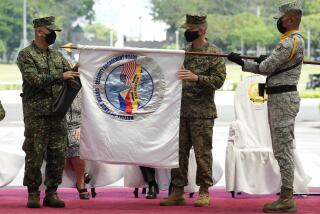U.S. Rejected Plea to Attack Rebels : Philippines: Washington limits its assistance to air cover to help the Aquino government.
- Share via
WASHINGTON — U.S. officials, called upon to help Philippine President Corazon Aquino fight off an attempted military coup, turned down requests for U.S. warplanes to bomb rebel-held air bases, fuel dumps and a freighter at sea, senior Bush Administration officials said Saturday.
“They wanted more than we gave them, which shows the panic they were in,” one official said, talking on condition of anonymity.
In the end, he and others said, the United States limited its assistance to flights of U.S. Air Force F-4 Phantom jets over rebel-held bases in a successful show of force intended to keep rebellious units of the Philippine air force on the ground. The U.S. pilots had orders to shoot at any Philippine rebels trying to take off.
The Administration official said the U.S. Embassy in Manila received a series of telephone calls, first from a senior military official loyal to Aquino, then from Defense Secretary Fidel V. Ramos, and finally from Aquino herself, Friday morning in Manila.
“They all asked for some sort of basic violence, in the form of air strikes,” the source said.
The Philippine military official, who was not identified, sought an attack on a freighter believed to be carrying munitions or reinforcements for the rebels. Ramos called for attacks on the air bases to disable rebel-controlled aircraft on the ground.
Aquino “wanted the fuel dumps and (an) armored column” to come under U.S. attack, according to the Administration official.
“The bottom line is, we gave them a lot less than they asked for,” he said. “We were the ones that thought up what was needed.”
A senior administration official Friday night had specifically denied in response to questions from The Times that Aquino had asked for any military assistance other than what was provided.
According to two sources, the intervention plan was devised by Gen. Colin L. Powell, chairman of the Joint Chiefs of Staff. Powell was working in the National Military Command Center on Thursday night and Friday morning as U.S. officials were scattered about Washington and in the White House Situation Room, and President Bush, flying aboard Air Force One to the Malta summit, sought to keep abreast of developments.
A “Combat Air Patrol” was launched approximately one half hour after Bush approved the mission, at about 12:30 a.m. EST Friday. Powell’s plan was sent to the White House, where Vice President Dan Quayle was presiding over the Administration’s efforts to assist Aquino, before being relayed to the airborne President.
“Powell and his people devised the idea of just an air cap,” one source said. “They thought that would do the trick, without any violence.”
U.S. officials took pains Saturday to portray the ultimate action as matching the assistance requested by Aquino. That portrayal reflected a decision Friday not to discuss the full range of military operations that Aquino and her aides had sought, out of concern that it would demonstrate the difficult position in which she found herself.
Similarly, officials were under instructions--not necessarily followed--to avoid discussing the possible impact the rebellion and U.S. assistance might have on renewal of the agreements under which the United States uses the Subic Bay Naval Base and Clark Air Base, the Pentagon’s two crucial bases in the Western Pacific.
One official, reflecting the concern that Aquino’s position not be made to appear any more serious than necessary, said Saturday evening: “All these different requests were from different levels of government, but Aquino got what she wanted.”
Under the plan devised by the U.S. officials, Quayle spoke with Aquino at about 1:30 a.m. Friday, an hour after the President’s decision was made, and carefully elicited from her--in a conversation that was tape-recorded--a specific request for the air patrol maneuver that had been decided upon.
This step was taken to protect the White House from any suggestion in the future that the move had been forced on the Philippines and had not been requested.
The officials also disclosed that although U.S. military advisers in the Philippines were said not to have played a key role in helping Aquino fend off the rebels, they had provided communications links between loyal elements of the military and the U.S. Embassy.
However, separate channels of communication were eventually set up between Powell and the White House, on the one hand, and Ramos in Manila, on the other, to offer direct information that bypassed the U.S. Embassy in Manila.
Officials stressed that Aquino had not been given a choice of military options by the United States. They were not offered anything,” said one official. He added, however, that there was “discussion about what we might do.”
More to Read
Sign up for Essential California
The most important California stories and recommendations in your inbox every morning.
You may occasionally receive promotional content from the Los Angeles Times.













